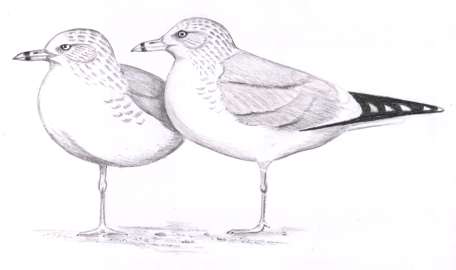
Dear Bird Folks:
Why is it that birds sleep standing on one leg? My aunt has a pigeon and we were wondering about this behavior. Also, how are they able to hear so well without the benefit of large ears, like mammals have? I hope I’m not cheating by asking two questions at once, but I would really appreciate the answers to both.
– Emily, Tupper Lake, NY
It’s OK, Emily,
There is no reason to feel guilty. I don’t mind two questions. Wondering about birds’ hearing is an excellent question. It is odd that birds can hear so well, yet they don’t appear to have any ears. As for the standing on one leg thing, I knew it was only a matter of time before that question came up. I might as well answer it now and get it out of the way.
Birds do, indeed, have excellent hearing, but like most things in nature, there are different designs for different creatures. Most land mammals have significant outer ears, or pinna (look it up, it’s a real word). Pinna size is not as important as many people think. If having large external ears allowed mammals to hear more, then Ross Perot would be listening to us right now. And elephants would have the best hearing of all, when in fact, elephants’ hearing is relatively poor. Their huge external ears are mostly used for cooling, defense posturing and in the case of Dumbo, flying.
Bird hearing is, at best, complicated and, at worst, boring to read about. I’m afraid if I got into too many details that even the people in prison would put down this newspaper and go back to staring at the walls. You should know, however, that it is the internal ear that is the key to birds’ hearing. The ear openings of birds are larger than you might think; it’s just that they are convered up with feathers. In many cases, the feathers are arranged to help channel sounds into the bird’s ear.
For years, keen-eared birds have been used as “watchdogs.” Before the days of radar, trained parrots were used in the military. The parrots could hear the hum of distant enemy planes and would squawk a warning long before the planes could be heard by humans. Pigeons also have excellent hearing. (So your aunt had better be careful what she says about it.) Homing pigeons apparently use audio clues (ocean sounds, waterfalls, etc.) as well as visual clues when finding their way back to the roost.
Now for your second question. Man, I would love to have a doughnut for every time someone came screaming to me about seeing a bird with a leg missing. Tucking up one leg is very common for birds to do, yet no one knows for sure why. The most common theory is to conserve heat. As you know, most birds have bare, naked legs without the covering of insulating feathers. By tucking up one leg, at least one leg can be insulated from the cold. Go to any Cape beach parking lot in the winter time and you’ll see dozens of one-legged gulls looking like they are ready to tip over.
That insulation idea makes sense, until you think about flamingos living in the zillion degree heat of Florida. Why would they ever need to keep warm? The thought here is that they lift up one foot simply to give it a chance to dry out. Standing in wet mud 24-7 has to be tough on a new manicure. Another theory is that by standing on one leg, flamingos change their silhouette and thus are able to fool predators into thinking they are some kind of odd vegetation. Although I think the real problem in trying to hide is not the number of legs, but the bright, fluorescent pink feathers, but what do I know?
Why would your aunt’s pigeon, living in a warm cozy house, still sleep on one leg? It probably stems from its wild heritage. Either that or your aunt’s house has some serious draft issues.